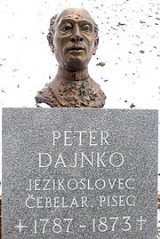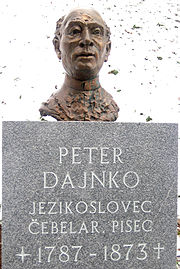
Peter Dajnko
Encyclopedia

Priest
A priest is a person authorized to perform the sacred rites of a religion, especially as a mediatory agent between humans and deities. They also have the authority or power to administer religious rites; in particular, rites of sacrifice to, and propitiation of, a deity or deities...
, author
Author
An author is broadly defined as "the person who originates or gives existence to anything" and that authorship determines responsibility for what is created. Narrowly defined, an author is the originator of any written work.-Legal significance:...
, and linguist, known primarily as the inventor of an innovative proposal for the writing system for Slovene: the Dajnko alphabet
Dajnko alphabet
The Dajnko alphabet or dajnčica was a Slovene writing system invented by Peter Dajnko. It was used in from 1824 to 1839 mostly in Styria ....
.
He was born in the village of Črešnjevci
Črešnjevci
Črešnjevci is a dispersed settlement immediately to the south of Gornja Radgona in northeastern Slovenia.The Slovene author and linguist Peter Dajnko was born in the village in 1787. The house in which he was born is a simple thatched farm house and now houses an ethnographic collection.-External...
near the town of Gornja Radgona
Gornja Radgona
Gornja Radgona is one of the municipalities and a town in Slovenia. Once it was a defensive stronghold for today's regional centre and its twin city, Bad Radkersburg, on the other side of the river Mura in Austria. The towns were split in 1919 when the state of Styria was divided between Austria...
, in what was then the Duchy of Styria
Duchy of Styria
The history of Styria concerns the region roughly corresponding to the modern Austrian state of Styria and the Slovene region of Styria from its settlement by Germans and Slavs in the Dark Ages until the present...
in the Habsburg Monarchy
Habsburg Monarchy
The Habsburg Monarchy covered the territories ruled by the junior Austrian branch of the House of Habsburg , and then by the successor House of Habsburg-Lorraine , between 1526 and 1867/1918. The Imperial capital was Vienna, except from 1583 to 1611, when it was moved to Prague...
. After finishing high school in Maribor
Maribor
Maribor is the second largest city in Slovenia with 157,947 inhabitants . Maribor is also the largest and the capital city of Slovenian region Lower Styria and the seat of the Municipality of Maribor....
, he studied theology
Theology
Theology is the systematic and rational study of religion and its influences and of the nature of religious truths, or the learned profession acquired by completing specialized training in religious studies, usually at a university or school of divinity or seminary.-Definition:Augustine of Hippo...
and philosophy
Philosophy
Philosophy is the study of general and fundamental problems, such as those connected with existence, knowledge, values, reason, mind, and language. Philosophy is distinguished from other ways of addressing such problems by its critical, generally systematic approach and its reliance on rational...
at the University of Graz
University of Graz
The University of Graz , a university located in Graz, Austria, is the second-largest and second-oldest university in Austria....
, where he graduated in 1814.
In 1824 he wrote a book in German
German language
German is a West Germanic language, related to and classified alongside English and Dutch. With an estimated 90 – 98 million native speakers, German is one of the world's major languages and is the most widely-spoken first language in the European Union....
called Lehrbuch der windischen Sprache (Textbook of the Slovene Language). In it, he proposed the adoption of a new alphabet for Slovene, which was to replace the traditional Bohorič alphabet
Bohoric alphabet
The Bohorič alphabet was an orthography used for the Slovene language between the 16th and 19th centuries. Its name is derived from Adam Bohorič, who codified the alphabet in his book Articae Horulae Succisivae, published in 1584....
, used since the late 16th century. According to Dajnko, the old script had shown clear deficiencies, since it did not fit well with the phonetic structure of Slovene. Dajnko's proposal, which included several characters not found in the Latin script, created a long-lasting controversy, which became known as the "War of Letters" . Among Dajnko's fiercest opponents were the philologist Matija Čop
Matija Cop
Matija Čop , also known in German as Matthias Tschop, was a Slovene linguist, literary historian and critic.- Biography :...
and the poet France Prešeren
France Prešeren
France Prešeren was a Slovene Romantic poet. He is considered the Slovene national poet. Although he was not a particularly prolific author, he inspired virtually all Slovene literature thereafter....
, while he did enjoy some initial support from the linguist Jernej Kopitar
Jernej Kopitar
Jernej Bartol Kopitar was a Slovene linguist and philologist working in Vienna. He also worked as the Imperial censor for Slovene literature in Vienna...
. In 1825, Franc Serafin Metelko
Franc Serafin Metelko
Franc Serafin Metelko, also known as Fran Metelko was a Slovene Roman Catholic priest, author, and philologist, best known for his proposal of a new script for the Slovene called the Metelko alphabet, which was meant to replace the traditional Bohorič alphabet, used since the late sixteenth...
came up with a similar proposal, further complicating the issue.
After 1839 his proposal became obsolete with the adoption of a slightly modified version of Gaj's Latin alphabet as the new Slovenian script. Dajnko nevertheless continued to use his own alphabet in all his later Slovene books.
Dajnko was also a professional beekeeper
Beekeeper
A beekeeper is a person who keeps honey bees for the purposes of securing commodities such as honey, beeswax, pollen, royal jelly; pollinating fruits and vegetables; raising queens and bees for sale to other farmers; and/or for purposes satisfying natural scientific curiosity...
and introduced several innovations in apiculture, following the example of his fellow countryman Anton Janša
Anton Janša
thumb|Anton Janša - portraitAnton Janša was a Slovene apiarist and painter. Janša is known as a pioneer of modern apiculture and a great expert in the field. He was educated as a painter, but was employed as a teacher of apiculture at the Habsburg court in Vienna.- Biography :Anton Janša was born...
.
He died in the town of Velika Nedelja
Velika Nedelja
Velika Nedelja is a settlement in the Ormož Municipality in northeastern Slovenia. The area traditionally belonged to the region of Styria. It is now included in the Podravska statistical region....
in his native Lower Styria
Lower Styria
Lower Styria or Slovenian Styria is a traditional region in northeastern Slovenia, comprising the southern third of the former Duchy of Styria. The population of Lower Styria in its historical boundaries amounts to around 705,000 inhabitants, or 34.5% of the population of Slovenia...
.
See also
- Slovene alphabet
- History of SloveniaHistory of SloveniaThe history of Slovenia chronicles the period of the Slovene territory from the 5th Century BC to the present times. In the Early Bronze Age, Proto-Illyrian tribes settled an area stretching from present-day Albania to the city of Trieste. The Holy Roman Empire controlled the land for nearly 1,000...
- Culture of SloveniaCulture of SloveniaSlovenia's first book was printed by the Protestant reformer Primož Trubar . It was actually two books, Katekizem and Abecednik, which was published in 1550 in Tübingen, Germany....
- Language reformLanguage reformLanguage reform is a type of language planning by massive change to a language. The usual tools of language reform are simplification and purification. Simplification makes the language easier to use by regularizing vocabulary and grammar...

